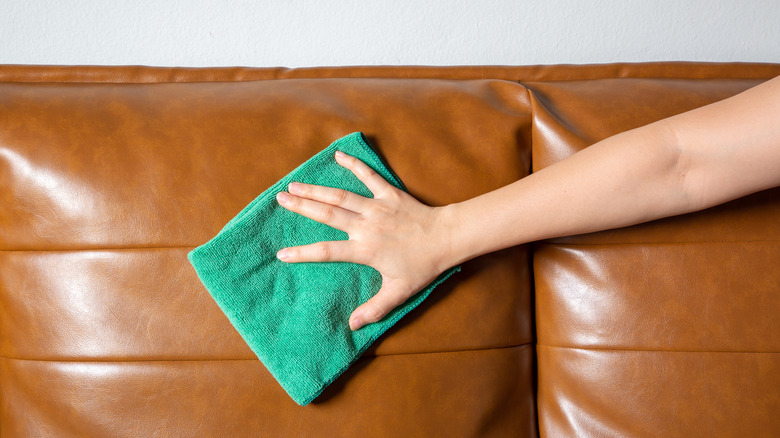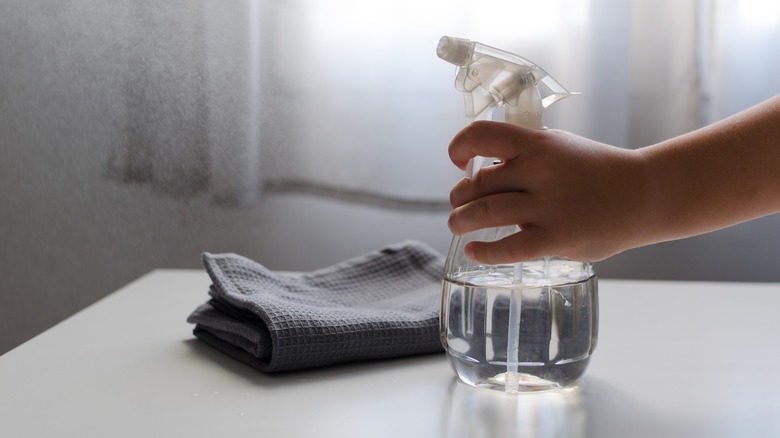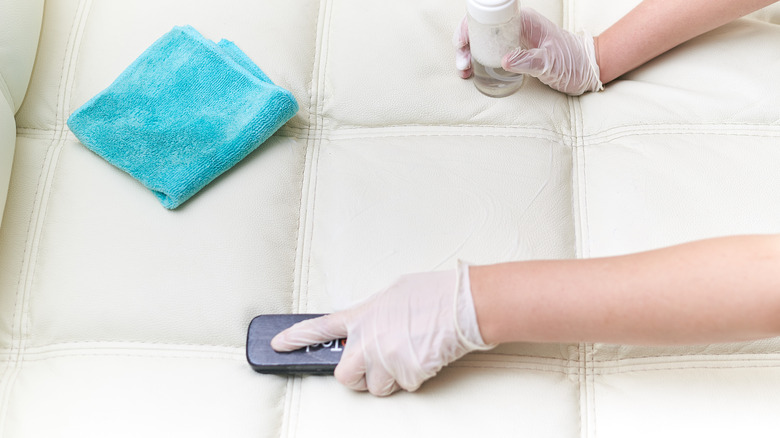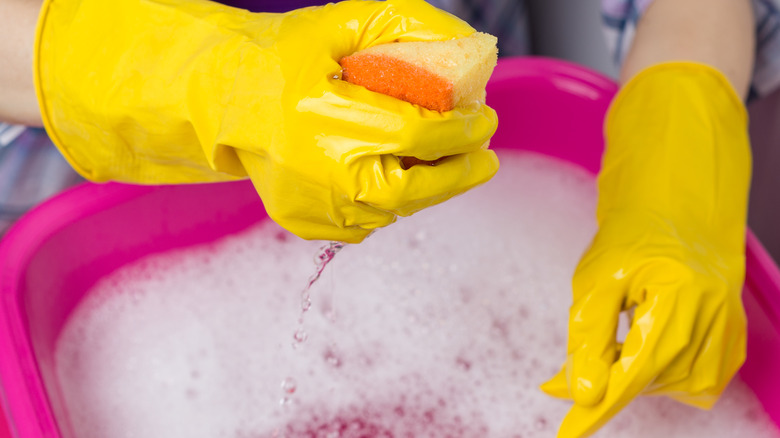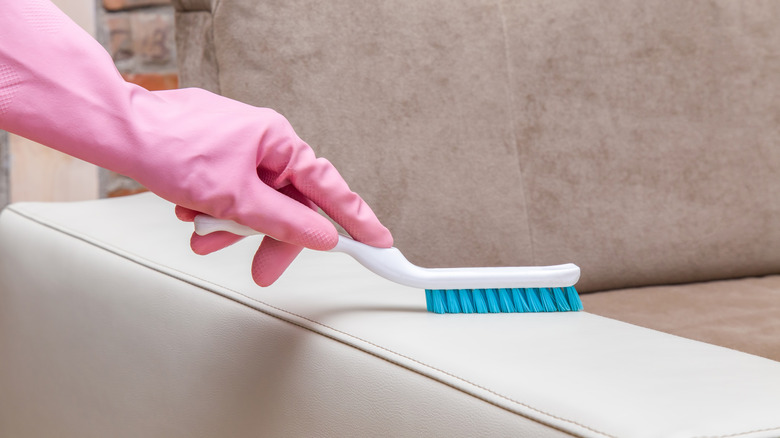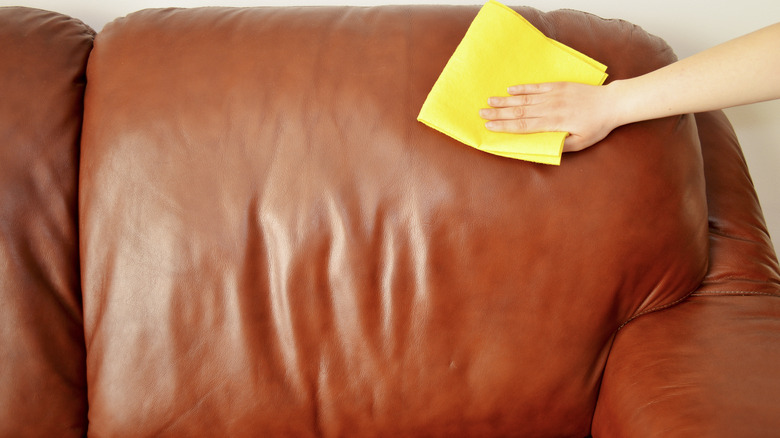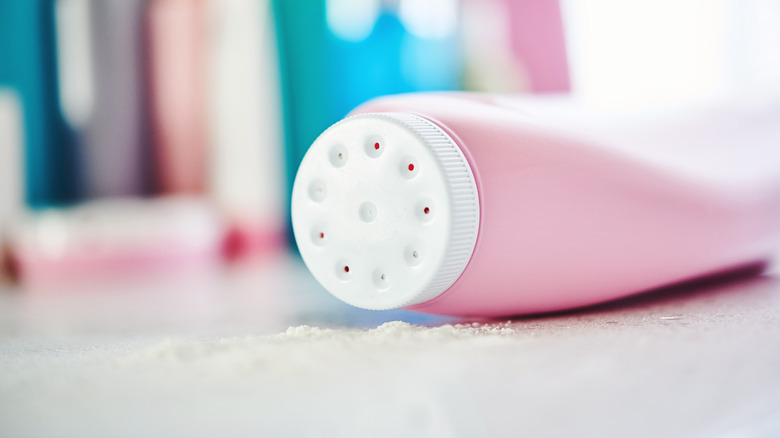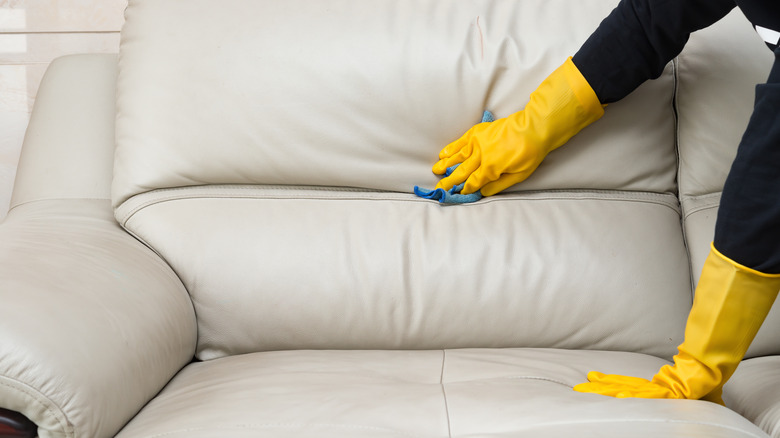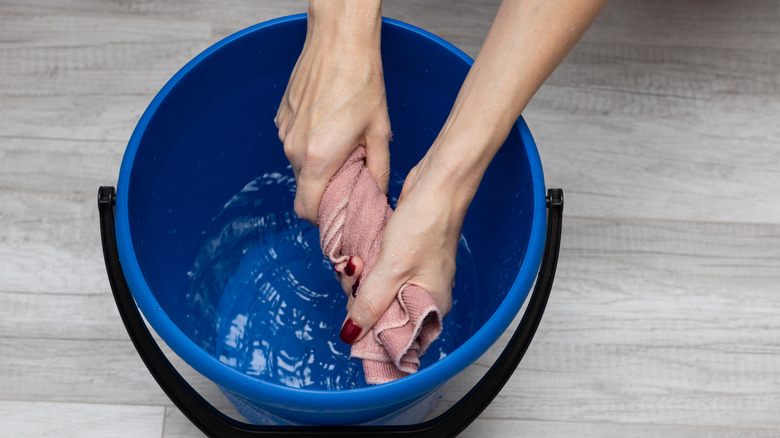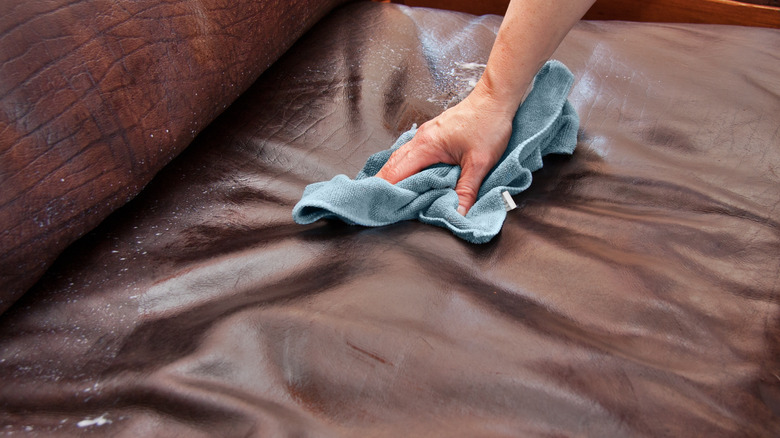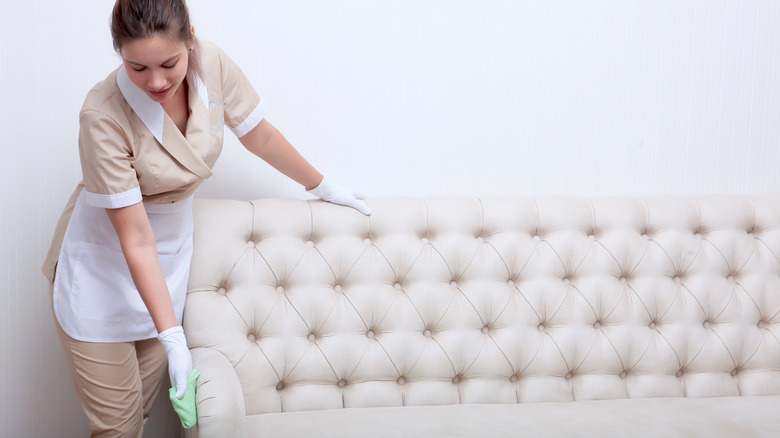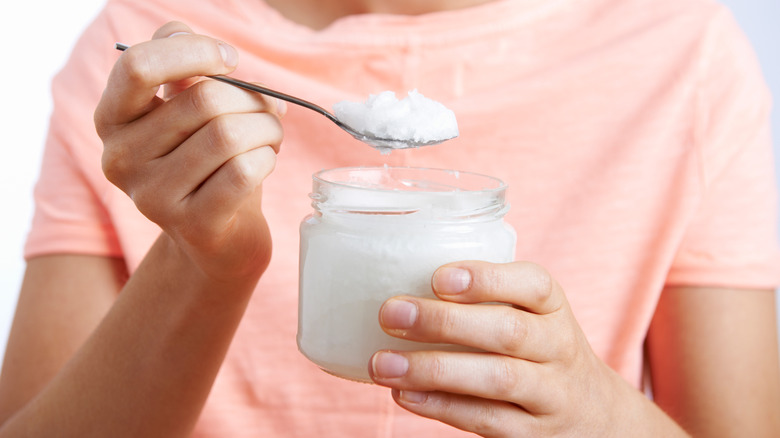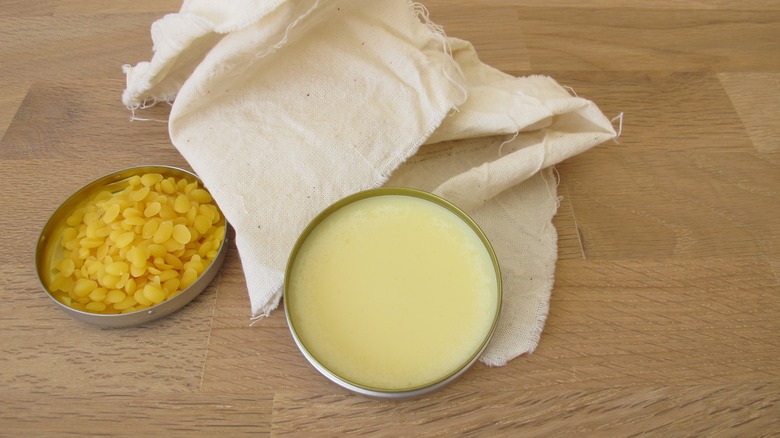Natural Ingredients You Should Be Using To Clean Your Leather Sofa
Leather sofas are popular because they're luxurious without requiring much upkeep to keep them in excellent condition. However, when you do have to clean your sofa, you don't want to grab just any cleaner. Instead of reaching for chemical-based products, you'll be happy to know there are several great natural options that'll give your leather sofa a beautiful shine and refresh. Ingredients like cornstarch, vinegar, and linseed oil clean while leaving the leather's natural oils intact, and you can use them to clean and condition the whole sofa. Also, these allow you to be more eco-friendly, while getting the same level of clean you want.
Getting into a more natural cleaning routine and figuring out how ordinary, everyday ingredients can work for you to care for your leather sofa opens up new doors. You can rethink your cleaning habits and focus on natural ingredients that offer a win-win situation for your leather furnishings and the environment.
White vinegar and water can kill bacteria
As you sit or lay on your leather sofa, bacteria can build up on the surface. However, using white vinegar diluted in water will help kill them. Before you use it, ensure you dilute it by adding 1 cup of both water and vinegar into a spray bottle and shaking it. Get a clean, white cloth and spray it with your mixture until it's damp to the touch, ensuring you don't soak it. You can oversaturate the leather by getting it too wet, and this can leave water marks or dark spots when you're done. Before you spray your whole couch with it, make sure it doesn't change the color of the leather by testing it on a small, hidden area.
Once you're ready, use the damp cloth to carefully wipe down the rest of your leather sofa in a circular motion to get rid of dirt, water spots, and germs. Step back when you're done, see if you can spot any lingering stains, and clean it again if you notice them. Finally, get a second dry cloth and wipe down the sofa to remove any remaining moisture to finish the project.
Acetic acid, which is found in vinegar, allows the solution to clean and gets rid of bacteria. The American Society for Microbiology found in 2014 that vinegar got rid of bacterium types that cause tuberculosis. It also works great for getting rid of other kinds of viruses and germs.
Denatured alcohol can help banish mold and mildew
Denatured alcohol is a strong cleaner that works well on some leather sofa issues, like ink stains, mold, and mildew growth. Add denatured alcohol to a clean, soft towel or cotton ball and slowly rub the alcohol into the spot. After two or three minutes, take it off and let it dry. This removes the stain, mold, or mildew without wetting the leather. You may have to do it again for spots that won't go away or for more stubborn mold growth. That being said, it can fade some fabrics and dyes, so test it first in a small, hidden area to ensure the leather doesn't lighten.
Denatured alcohol is a solvent, which is why it cleans your leather couch so well. Putting it on ink spots breaks down the chemicals in the ink, making it easier to lift without spreading. When used on mold and mildew, it kills the spores like a disinfectant and also stops them from spreading. Since it evaporates quickly, there is less chance that water will damage your sofa. It cleans and sanitizes the surface to make it healthier for you to sit on.
Castile soap can lift grime
Mix a few drops of Castile soap with water in a bowl to get an effective, but gentle, clean on your leather sofa. Diluting the soap ensures it's gentle enough to use on leather without damage. Get a soft, clean cloth and dip it into the bowl, wring out any excess liquid, and wipe your sofa down using circular motions. Target any grimy or dirty spots you see — just make sure you don't scrub too hard. Be aware that this soap can leave a light residue, so rinse the sofa by running a clean, damp cloth over it once you're finished to remove any soap traces.
Castile soap is a good choice as a cleaning agent for leather due to its natural formula. It's made from vegetable oils, allowing it to clean without using chemicals many traditional cleaners contain. The natural base ensures it's very gentle on leather, preserving the natural oils and look. Castile soap is also suitable for leather because it keeps it soft and stops it from cracking when it gets dry. Also, the soap is eco-friendly, making it a great choice if you want to clean while using products that are better for the environment and don't contain harmful chemicals.
Cornstarch can help clean up spills
Cornstarch is an excellent natural remedy to remove spill stains from your leather sofa. Start by sprinkling the cornstarch over the impacted area, ensuring you cover the whole stain. Merry Maids recommends you leave it on the stain for several hours to overnight as it goes to work, absorbing the oil or grease from your sofa. After a few hours, get a soft brush or a dry, clean cloth and wipe the powder from the leather's surface. You may need to repeat this for stubborn stains, and it works best when you use it on fresh stains, because it'll absorb the spills before they seep into the leather.
Cornstarch works well for leather sofas because it doesn't need water to work. The molecules in cornstarch are naturally absorbent, making them great to draw out the spills from the leather's surface. By leaving the natural oils in the leather and stopping water from staining it, this dry-cleaning method helps keep your leather sofa in good shape. This approach will protect the look and lifespan of your leather sofa, and it is an easy, eco-friendly way to clean up everyday spills. Given the delicate balance of cleaning and maintaining leather, cornstarch provides a mild but effective way to preserve the material's quality and appearance.
Use a mild, natural soap solution to clean surface grit
A practical and gentle way to clean everything from mirrors to leather surfaces is to make a solution of water and natural soap, like unscented glycerin. It's easy to do, and you get a bowl of warm water and dissolve a little of the soap into it to make suds. Get a clean, soft cloth and dip it into your sudsy water, wring it out so it's damp, and wipe your leather sofa down, working in a circular motion. Don't soak the cloth because it can leave water marks on the leather's surface that you'll have to go back and try to remove. When you're done, give the whole couch another pass with a second damp, clean rag to ensure you don't have any residue left that will dry into an icky film.
This mild, natural soap allows you to clean your leather sofa without resorting to chemical-laden products that remove the natural oils. Glycerin-based soap is very gentle and ensures that your leather stays supple and soft. It's a great way to get into a greener cleaning routine, while helping your leather furniture last longer. As a bonus, since the leather keeps the natural oil content, it helps reduce wear and tear from daily use.
Talcum powder can absorb dry stains
Talcum powder, also known as baby powder, is a gentle but effective way to get rid of dry stains on your leather couch. To remove the stains, sprinkle a thin, even layer right on top of the spot, making sure to cover the whole thing, then use a soft white cloth to rub it in. Leave it alone for the night so the powder has time to work on the color. Slowly scrub the talcum powder off the sofa the next day with a soft brush. The powder should remove the stain, but if it doesn't, do it again.
Talcum powder works to clean leather surfaces due to its ability to absorb oil or grease. The powder is very finely milled, letting it get into the leather's pores and slowly pulling out the stain. It does this without causing damage to the leather sofa's surface and without you needing to use other harsh chemicals to activate it. Talcum powder not only cleans, but also helps keep the leather soft. To help leather furniture keep its natural beauty and last longer, this method is surely something to consider.
Non-gel, white toothpaste can remove minor scuffs
White, non-gel toothpaste is a good choice for gently and effectively removing minor scuffs and marks from your leather sofa. First, put a pea-sized amount of toothpaste on a clean, dry cloth. Avoid using too much because it will make a mess. In a circular motion, gently rub the cloth over the area on your sofa that is scratched or marked. This gentle agitation will slowly lift the stain from the leather. However, don't push too hard; it could damage the leather's surface and create a lighter spot. After treating the scuff, get a damp cloth, wipe away any residue, and see if the scuff is gone. If it's not, you may have to do it again, taking care not to damage the leather.
The reason a white non-gel toothpaste works to clean leather is due to the mild abrasiveness it offers. This allows you to use it to tackle minor marks and scuffs that take away from your couch's look. Unlike harsh chemical-based cleaners that can strip away the natural oils or damage the finish, toothpaste cleans effectively without compromising the leather's integrity. Toothpaste's abrasive components are so fine that they can lift marks and scuffs without scratching the couch. Also, not using gel-based toothpaste with dyes reduces the risk of leaving residues or stains behind that could trap dirt or be an eyesore.
Use warm water and a soft cloth to get rid of dirt
A soft cloth and warm water will clean your leather sofa and keep it looking good. Ensure the water is warm before you start and avoid using hot water because it could damage the leather's surface. Wet the cloth with the warm water and squeeze it out so it's damp. Carefully wipe your cloth over the leather's surface, paying particular attention to areas where you see dirt or marks. Then, it's time to buff the leather to remove any extra water. Get a clean, dry cloth and do this. It's easy to clean your sofa, but be careful not to get the fabric too wet or it'll stain.
Leather is a delicate but durable material that usually needs minimal care to keep it looking nice. When you use warm water correctly, it helps get rid of surface dirt and minor stains without any abrasive cleaning methods. This approach also helps the sofa keep its natural oils, preventing it from cracking or drying out.
Linseed oil can restore the leather's flexibility
You can use linseed oil on your floors to help clean and protect them, and the same can be said for leather. Create a homemade leather conditioner by mixing white vinegar with linseed oil in a 1:1 ratio. Using a clean, soft cloth, apply a light layer to your leather couch, being careful so you don't oversaturate any specific place. After you apply it, get a second clean cloth, buff the leather to get a natural shine, and spread your mixture evenly over the surface. However, test a small area and use a very light hand when you apply it because, as ISKO Leathers points out, linseed oil can make leather darker. Testing before you go over the whole couch ensures it doesn't change the leather's look.
Combining vinegar with linseed oil offers several benefits for your leather. First, linseed oil will sink deep into the leather to help restore its natural flexibility and prevent it from getting brittle and cracking with age. The linseed oil will replace the natural oils the couch lost due to exposure and wear. Vinegar helps clean the leather, stripping away grime and surface dirt to give you a clean finish. Together, they offer you a balanced approach to leather care, ensuring the sofa is cleaned and well-conditioned.
Use vegetable glycerin to help retain moisture
Putting vegetable glycerin on your leather sofa will keep it soft and in good condition. To do this, put a little on a clean, soft cloth and gently wipe the sofa in a circular motion. The goal is to add a thin, even layer that penetrates the leather and doesn't just sit on top. After applying it, leave it on for a few minutes, then buff the surface with a clean cloth to get a soft, smooth finish. You should know, though, that applying too much at once can over-condition the leather and make it feel sticky, which can cause dirt and dust ahere to it.
It helps to use vegetable glycerin on your leather sofa because it's a humectant, which means it pulls moisture from the air and, in this case, into the leather (via Nature Publishing Group). So, it's a great way to keep your sofa in good shape, especially if you live somewhere with a dry climate. Vegetable glycerin keeps your sofa soft and flexible by locking in moisture. It also helps the leather stay more flexible and luxurious.
Coconut oil can moisturize the leather
Before using coconut oil to moisturize your sofa, clean it and make sure it's dry. Once it is, get some coconut oil and put it on a clean cloth. Using a circular motion, gently rub it into the sofa. When you finish the entire sofa, give the oil a few minutes to soak into the leather, and then get a second cloth and buff the leather to get rid of any excess oil and make it shine. However, even though coconut oil can make your leather furniture look new, it can also darken some types of leather. So, test a small area first to see how it reacts with your specific sofa.
Coconut oil offers natural moisturizing properties, so it works well with leather, which needs regular hydration to help stop it from cracking. The oil's fatty acid content gives it the moisture required to keep the leather supple. The oil sinks into the leather and replenishes the moisture without leaving a greasy feel, as long as you apply an even layer and wipe off the excess. Also, this oil leaves a very mild, but pleasant, scent without artificial fragrances. Finally, the protective layer your sofa gets from the oil also offers some resistance against wear and staining, extending the life of your leather sofa.
Beeswax works to repel water
Beeswax is a natural and effective way to care for your leather sofa. Start by gently melting a small amount of beeswax and get a soft cloth to spread over the sofa's surface. Once you finish, give the beeswax time to cool and sink into the leather before taking another cloth and buffing the sofa to get a nice shine. Ensure that the beeswax absorbs into the leather as you work to avoid leaving a waxy residue. If you add too much beeswax or don't buff it, the sofa can feel sticky or have a build-up that attracts dirt and dust. To prevent this, apply the beeswax in thin layers and take time to buff the leather thoroughly after each application. This will help achieve a protective finish without compromising the look or feel of your leather sofa.
Beeswax acts as a natural protectant, creating a barrier on the surface of the leather that repels water and prevents stains from setting in. This barrier also protects against everyday wear and tear, helping to maintain the leather's appearance over time. Carolina Honeybees points out that beeswax nourishes the leather, providing essential moisture to prevent drying and cracking. Its natural composition also makes it a safer alternative to chemical-based products.

